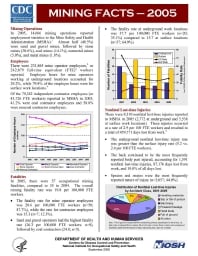Mining Publication: Mining Facts - 2005
Original creation date: September 2008
Authors: National Institute for Occupational Safety and Health
NIOSHTIC2 Number: 20034740
Pittsburgh, PA: U.S. Department of Health and Human Services, Public Health Service, Centers for Disease Control and Prevention, National Institute for Occupational Safety and Health, DHHS (NIOSH) Publication No. 2008-149, 2008 Sep; :1-2
Mining Operations: In 2005, 14,666 mining operations reported employment statistics to the Mine Safety and Health Administration (MSHA). Almost half (48.5%) were sand and gravel mines, followed by stone mines (30.6%), coal mines (14.1%), nonmetal mines (5.0%), and metal mines (1.8%). Employees: There were 231,865 mine operator employees, or 242,879 full-time equivalent (FTE) workers reported. Employee hours for mine operators working at underground locations accounted for 20.2%, while 79.8% of the employee hours were for surface work locations. Of the 79,262 independent contractor employees (or 45,726 FTE workers) reported to MSHA in 2005, 41.2% were coal contractor employees and 58.8% ere noncoal contractor employees. Fatalities: In 2005, there were 57 occupational mining fatalities, compared to 55 in 2004. The overall mining fatality rate was 19.8 per 100,000 FTE workers. The fatality rate for mine operator employees was 20.6 per 100,000 FTE workers (n=50; 87.7%), while the rate for contractor employees was 15.3 (n=7; 12.3%). Sand and gravel operators had the highest fatality rate (26.3 per 100,000 FTE workers; n=9), followed by coal contractors (24.8; n=5). The fatality rate at underground work locations was 37.7 per 100,000 FTE workers (n=20; 35.1%) compared to 15.7 at surface locations (n=37; 64.9%). Nonfatal Lost-time Injuries: There were 8,310 nonfatal lost-time injuries reported to MSHA in 2005 (2,772 at underground and 5,538 at surface work locations). These injuries occurred at a rate of 2.9 per 100 FTE workers and resulted in a total of 459,771 days lost from work. The underground nonfatal lost-time injury rate was greater than the surface injury rate (5.2 vs. 2.4 per 100 FTE workers). The back continued to be the most frequently reported body part injured, accounting for 1,591 nonfatal lost-time injuries, 87,176 days lost from work, and 19.0% of all days lost. Sprains and strains were the most frequently reported nature of injury (n=3,657; 44.0%).

NIOSHTIC2 Number: 20034740
Pittsburgh, PA: U.S. Department of Health and Human Services, Public Health Service, Centers for Disease Control and Prevention, National Institute for Occupational Safety and Health, DHHS (NIOSH) Publication No. 2008-149, 2008 Sep; :1-2
- Coal and metal/nonmetal mining facts - 2008
- Coal and Metal/Nonmetal Mining Facts - 2008 (HTML)
- Coal Contractor Mining Facts - 2001
- Coal Contractor Mining Facts - 2002
- Coal Contractor Mining Facts - 2003
- Coal Contractor Mining Facts - 2004
- Coal Contractor Mining Facts - 2005
- Coal Contractor Mining Facts - 2006
- Mining Fact Sheets
- Rib Falls: A Major Ground Control Issue